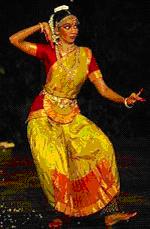
I COULD not take my eyes off her face. No, this is not an introduction to a love story, but rather, a confession of what struck me most in Sharira – My Body My Temple, a solo bharatanatyam performance by Daisyga Rani from Kalpana Dance Theatre. She presented it as part of the Under the Stars Series 2006: Second Flush by Sutra Dance Theatre last weekend at Amphi-Sutra, Kuala Lumpur.
There are many ways a dancer can manipulate the movement vocabulary in bharatanatyam, but the expression (abhinaya) she projects makes a marked difference in the quality of delivery. The presentation by Daisy (as she is fondly known) is one such example, and it was refreshing to see her emphasis.
Daisy performed her arengetram (graduation) in February 1999 and has since been actively performing and teaching bharatanatyam in Malaysia.
Watching her perform was like watching a silent movie, except that it was live and in colour! From Puspanjali (an offering of flowers) to Ananda Narthana Ganapathy (a devotional item for Lord Ganesha), Daisy delighted by “talking” to the audience with an animated expression. She had so much energy and so much spirit in her.
In the Varnam, a piece that emphasises the need to be united with Shiva, Daisy displayed her technical mastery. She was not rushed in her execution and had a good sense of timing. What was attractive about this piece was the amount of attention paid to details, such as the description (through dance) of a leaf falling to the ground and a seed thrown upwards, which then blossomed in mid-air, among others.
Keerthanam – Chinna Chinna Padan (Little Krishna) was an interesting depiction of Krishna. It was the first time I’d seen Krishna depicted as a child. The opening of this piece had several children dressed as “little Krishna”, each in a different mode of play. The scene ended, to everyone’s delight, with one of them drinking buttermilk from a pot – a familiar scene from stories of Krishna’s childhood.
While the children had no problem playing little Krishna, portraying a kid was no child’s play. Daisy was only able to hold the role convincingly in parts.
In Padam – Netrandi Nerathila, Daisy played a heroine who sees her lover, Lord Muruga, flirt with another woman by a riverbank. In the dance, she confronts her lover and describes her pain. Wonderful as she is as an actress, the dance repertoire was overwhelmed by too much storytelling.
Finally, when the Thillana, a pure dance item, came on, I sat back and simply enjoyed the physical beauty of a trained body in movement.
In this production, Shangita Namasibayam, Daisy’s bharatanatyam teacher for 15 years and also artistic director of Kalpana, worked with Lam Ghooi Keat from the Temple of Fine Arts on the narration. They did a good job of carefully choosing words that best explained the meaning of each item in the repertoire.
1 comment:
Hi,
Would have the meaning to "Ananda Narthana Ganapathy" song?
Post a Comment